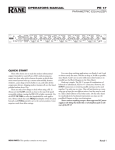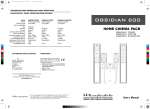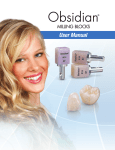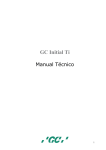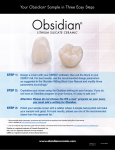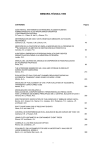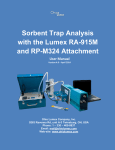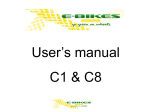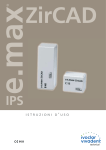Download Obsidian Milling Blocks Instructions for Use
Transcript
Obsidian® Milling Blocks Instructions for Use Manufactured by 0086 EC ENGLISH Glidewell Direct 18651 Von Karman Ave. Irvine, CA 92612 Within U.S.: 888-303-3975 Within Canada: 888-278-0414 For all others: 001-949-399-8411 Fax: 800-579-8233 www.glidewelldental.com REP MDSS Schiffgraben 41 30175 Hannover, Germany Prismatik Dentalcraft, Inc. (A wholly owned subsidiary of Glidewell Laboratories) 2212 Dupont Drive Irvine, CA 92612, USA 888-303-6470 Fax: 800-579-8233 Table 3 — Preparation Guidelines Do not discard Instructions during product use. NOTE: Please refer to the Obsidian Milling Blocks User Manual for more detailed instructions. ® Recommended Minimum Thickness Reduction for Full Anatomy Restorations 1. Product Description Obsidian® Milling Blocks are lithium silicate ceramic to be supplied with or without an attached mandrel using CAD/CAM methods. The product can produce a variety of monolithic restorations with great esthetics, life-like translucency and high strength including full-contour crowns, inlays, onlays, veneers, partial crowns and substructures due to its excellent machining properties. The milling blocks will be available in the commonly used VITA® Classical and Chromascop® Bleach shades. Anterior Veneer 2. Indications for Use This device is used to fabricate ceramic dental prostheses in the nature of single-unit crowns for posterior and anterior applications using CAD/ CAM methods. Posterior 3. Contraindications Single Units (standard) Libial/Lingual Incisal/Occlusal ≥ 1.2 mm ≥ 1.5 mm Margin area (Shoulder/Chamfer) ≥ 1.0 mm Cervical Labial Incisal Edge ≥ 0.6 mm ≥ 0.6 mm ≥ 0.7 mm Margin Area ≥ 0.6 mm Buccal/Lingual Incisal/Occlusal ≥ 1.5 mm ≥ 1.5 mm Margin area (Shoulder/Chamfer) ≥ 1.0 mm There are no known contraindications. 4. Technical Data Table For optimum milling and restoration integrity, the following criteria are also recommended: Table 1 — Type II, Class 3 The margin area should be a shoulder or chamfer with at least 1.0 mm clearance with NO sharp angles. As measured according to ISO 6872 Coefficient of Thermal Expansion (CTE) (298-773K) 12.2 x 10 ^-6/deg K Flexural Strength 385 +/- 45 MPa Weibull Characteristic strength 404 MPa For inlays and onlays, the preparation must be expulsive with at least a 6 degree angle. The preparation should have no sharp angles. Always have a round preparation on margins, as well as on occlusal table and cuspid reduction. 5. Design of Restorations Avoid significant changes in thickness confined to a small area within the restoration. Preparation guidelines and minimum thickness recommendations are shown in Tables 2 and 3. Failure to comply with these recommendations may result in chipping, delamination, and/or fracture of the final restoration. For the best results and clinical success, more attention should be given to design. The software-generated design of the restoration may need to be adjusted for each individual clinical situation. For detailed design guidelines including those for inlay, onlay and partial crowns, please refer to the User Manual. NOTE: Obsidian® undergoes a linear shrinkage of 0.1% during the crystallization process. For specific instructions on design of the restorations, please refer to the applicable CAD manual designated for your CAD system. Full-contour crowns should follow the same minimum thickness rules. Table 2 — M inimum Thickness (in mm) for Obsidian® Restorations Crowns Inlay Onlay Veneer Partial Crown Anterior Premolar Molar Circular 1.0 * 1.0 0.6 1.5 1.2 1.5 1.5 Incisal/ Occlusal 1.0 * 1.0 0.7 1.5 1.5 1.5 1.5 * isthmus width 6. Milling Obsidian® Milling Blocks are designed for CAD/CAM procedures that utilize a milling device. These can be larger milling machines in the laboratory environment or chairside milling equipment, which most likely use a mandrel system to secure the Obsidian® Milling Block into a fixture. Please follow the manufacturer’s operating instructions specific to the CAM device in order to position the Obsidian® Milling Block correctly. The CAD software needs to be followed in order to have a successful data transfer to the CAM device and a problem-free milling procedure. 7. Finishing After milling, carefully remove the restoration from the still-attached block and finish the restorations with the recommended tools at low speeds with light pressure (see User Manual for specific information). All diamond tools used on Obisidian® restorations must be of fine grit size (10-75 microns). Any diamond tool with a grit size greater than 75 microns is not recommended for use either intra-orally or extra-orally. Page 1 of 2 3033775_1.1 ECO #3034352 GD-1058-071315 Failure to use recommended tools, or their equivalent, may result in chipping or fracture of the final restoration. See the User Manual for additional information. All finishing is to be done prior to crystallization. After crystallization, it is recommended that NO additional finishing be performed. restoration. For recommended accessories and detailed instructions on their use, please refer to the Obsidian® User Manual. Failure to use the recommended accessories may result in chipping or fracture of the final restoration. See section 14 of this IFU for User Manual download/ordering information. 10. Adjusting the Crystallized Restorations 8. Crystallization All Obsidian milled restorations must go through a final Crystallization Cycle (Table 4). It is recommended that NO additional finishing be performed after the restoration is in the crystallized and finished glaze phase. Prior to crystallization, clean the restoration in an ultrasonic water bath or blast with a steam jet. 11. Cementation ® Apply stain and spray glaze. For chairside restorations, stain and/ or glaze application is optional. Instead, the restoration can be handpolished to a highly esthetic appearance. Refer to the User Manual for specific instructions on hand-polishing Obsidian restorations after crystallization. Program your oven using the applicable oven manual. Always support the inside of the crown with firing paste and a peg for crystallizing Obsidian restorations. Only use the standard ceramic pegs on a standard honeycomb firing tray. Crystallization and glaze; or crystallization, stain and glaze; can be conducted in a single combined cycle. See the User Manual for details. TABLE 4 — Crystallization Heating Cycle for Obsidian® Milling Blocks Ivoclar Programat ® CS2, EP 5010, EP 5000, P300 or similar Vacuum Quality 72 mbar N/A 400ºC 3 minutes 90ºC/min N/A 780ºC 10 seconds 40°C/min N/A 820ºC 10 minutes 50ºC/min N/A Long-term Cooling L 680ºC N/A Vacuum 1 Level V1 1 (on) / V2 1 (off ) 400ºC 780ºC Vacuum 2 Level V1 2 (on) / V2 2 (off ) 780ºC 819ºC Standby Temperature / Closing Time S Heating Rate t 1 ä Holding Temperature T 1 / Holding Time H 1 Heating Rate t 2 ä Holding Temperature T 2 / Holding Time H 2 Cooling Rate æ t L Entry Temperature / Entry Time Soak Time 72 mbar N/A 400°C 3 minutes 0 minutes N/A The dental professional should use conventional, adhesive resin or self-adhesive resin cement for luting Obsidian. Adhesive cementation requires salinization or conditioning of the bonding surface of the restoration. Adhesive cement is preferred for inlay, onlay, and partial crown. Anterior and posterior full restorations can be cemented with conventional, adhesive resin or self-adhesive resin cements. 12. Storage efore storing Obsidian® blocks, ensure there is NO damage such as B cracks and chips in the block. The blocks should be stored at room temperature and away from dust, contamination and humidity. When NOT in use, store blocks in the original packaging. 13. WARNING Do NOT inhale dust. Do NOT get dust into eyes or have prolonged contact directly with the skin. Personal Protective Equipment (PPE) such as gloves, masks and lab coats are recommended in order to avoid possible contact and irritation to skin or eyes during processing. To request the MSDS/SDS for this product, call Glidewell Direct in the U.S. at 1-888-303-3975. 14. User Manual For a copy of the Obsidian® Milling Blocks User Manual, please visit www.ObsidianCeramic.com/resources or call Glidewell Direct at 1-888303-3975. 15. Questions/Comments For questions and/or comments, or for further instructions regarding the use of this product, contact Glidewell Direct in the U.S. at 18651 Von Karman Ave., Irvine, CA 92612 or call 1-888-303-3975. Whip Mix® Pro 100 Vacuum Quality The restorations must be etched prior to cementing. Refer to the User Manual for etching instructions (HF concentration and etching time). 16. Symbols Only 1st Heating Rate / 1st Temperature 90°C/min 780°C 2nd Heating Rate / Final Temperature 40°C/min 820°C Hold Time 10 minutes N/A 680°C 1 minute Yes N/A Lower Table / Cool Time Use Vacuum Consult Instructions for Use Manufacturer LOT Batch Code Manufactured Date By Prescription Only Caution REF Reference Number NOTE: Step-by-step instructions for adding an Obsidian firing program for different model furnaces can be found at www.ObsidianCeramic.com/resources. Do NOT open furnace or remove the crystallized restorations until your furnace cools sufficiently for safe removal. Refer to the operating instructions for the particular oven used for proper use, placement of the product, and calibration. Ensure that the oven used is calibrated according to the particular manufacturer’s specifications. Contact your oven manufacturer for further instructions. 9. Stain, Glaze, Veneering and Add-On (Accessories) If desired, stain, glaze, veneering or add-on may be applied to the milled Page 2 of 2 3033775_1.1 ECO #3034352 GD-1058-071315


